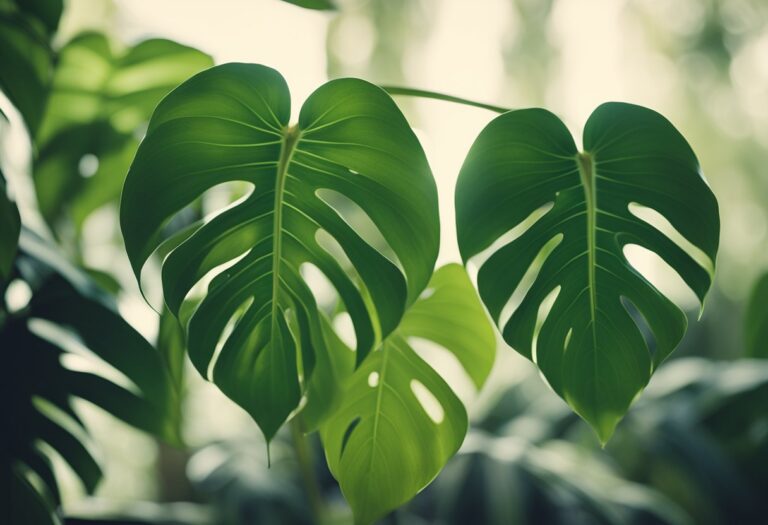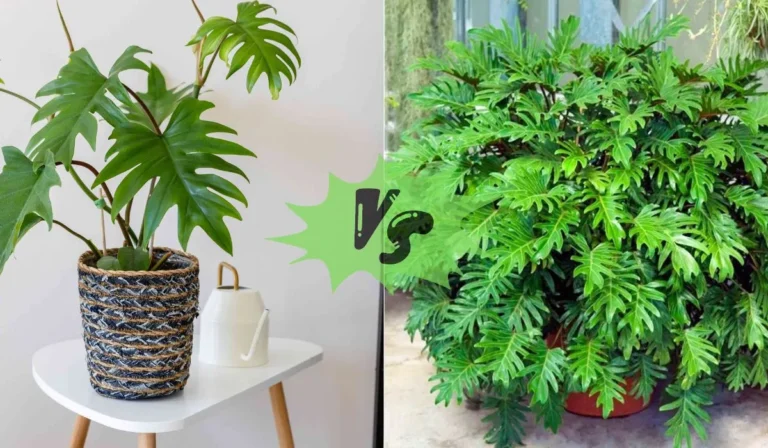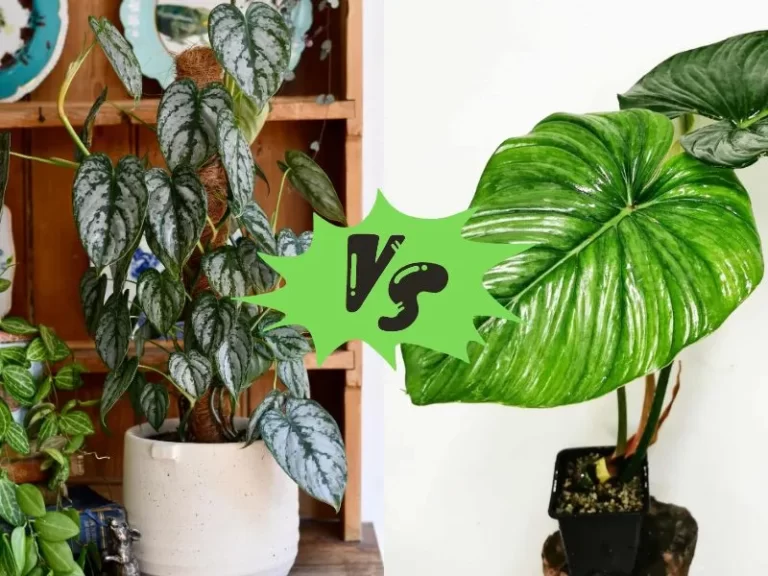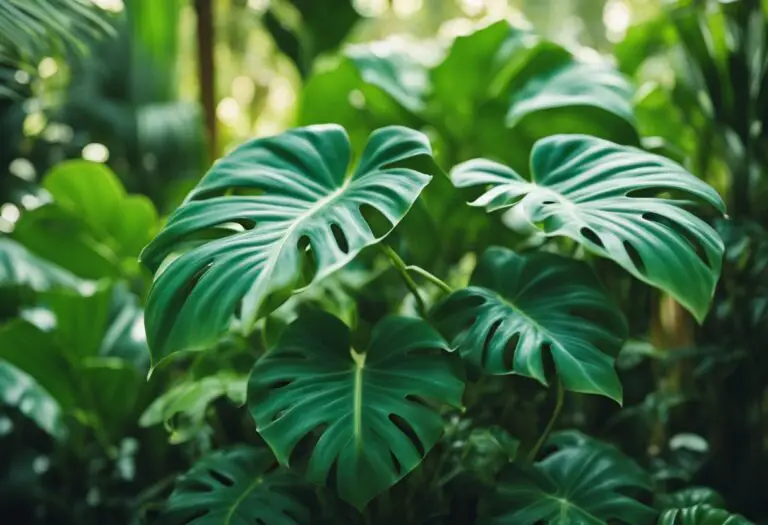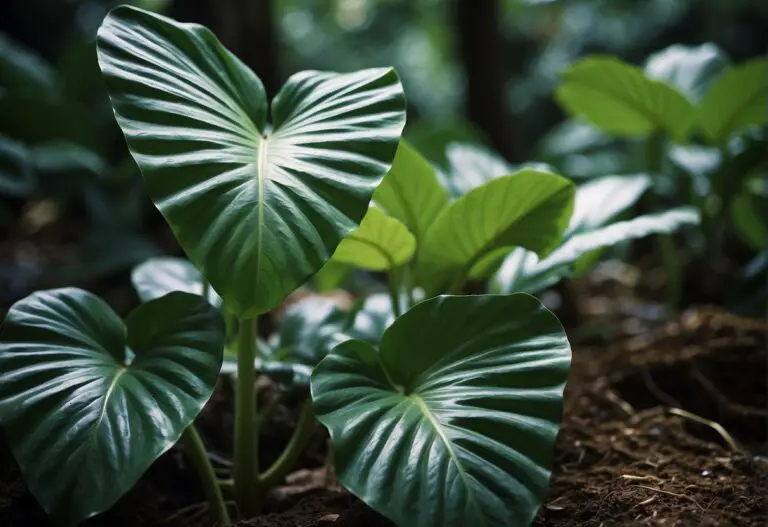Alocasia Odora vs Macrorrhiza: A Friendly Comparison
If you’re looking for a statement plant that commands attention, then you might want to consider the Alocasia family. Alocasia plants, also known as elephant ears, are known for their large, striking leaves and their ability to add a tropical feel to any space.
Two popular members of this family are Alocasia Odora and Alocasia Macrorrhiza, which are often compared due to their similarities and differences.

Alocasia Odora and Alocasia Macrorrhiza have some similarities, such as their preference for bright, indirect light and their need for well-draining soil.
However, they also have some key differences, such as their size and leaf shape.
Alocasia Odora typically grows to a height of 4-8 feet, while Alocasia Macrorrhiza can reach heights of 12-15 feet.
Additionally, Alocasia Odora has elongated, lance-like leaves, while Alocasia Macrorrhiza boasts large, heart-shaped leaves.
Understanding the differences between these two plants can help you decide which one is right for you.
Key Takeaways
- Alocasia Odora and Alocasia Macrorrhiza are both members of the Alocasia family, known for their large, striking leaves and tropical feel.
- While these two plants have some similarities, they also have key differences in size and leaf shape.
- Understanding these differences can help you choose the right plant for your space.
Understanding Alocasia Odora

If you are interested in growing Alocasia plants, you might want to learn more about Alocasia Odora. This plant is known for its unique appearance and pleasant fragrance. Here are some things you should know about Alocasia Odora:
Origin and Habitat
Alocasia Odora is native to Southeast Asia, particularly in countries like Thailand, Indonesia, and Malaysia. It prefers to grow in warm, humid climates and can be found in tropical rainforests. In the wild, it can grow up to 8 feet tall and 3 feet wide.
Characteristic Features
One of the most noticeable features of Alocasia Odora is its large, glossy leaves. The leaves are typically green and shaped like an arrowhead, with a pointed tip and a long stem. The leaves can grow up to 2 feet long and 1 foot wide.
Another unique feature of Alocasia Odora is its pleasant fragrance, which is most noticeable at night.
Growth Habits
Alocasia Odora is a relatively easy plant to grow, as long as you provide it with the right conditions. It prefers well-draining soil and partial shade, although it can tolerate some direct sunlight.
It also needs to be watered regularly, but be careful not to overwater it, as this can cause root rot. With the right care, Alocasia Odora can grow up to 8 feet tall and 3 feet wide.
Exploring Alocasia Macrorrhiza

If you’re looking for an elephant ear plant that can make a statement in your garden or home, Alocasia Macrorrhiza is a great choice. This plant is known for its large, heart-shaped leaves that can grow up to 3 feet long and 2 feet wide. Here’s what you need to know about this fascinating plant:
Native Range and Environment
Alocasia Macrorrhiza is native to Southeast Asia and is commonly found in tropical rainforests. This plant prefers warm, humid conditions and indirect sunlight, making it well-suited for tropical climates or indoor cultivation with proper care.
Distinctive Traits
One of the most noticeable features of Alocasia Macrorrhiza is its large leaves. These leaves are usually green but can also be bluish-green in color. They have a velvety texture that makes them stand out from other plants.
Another distinctive trait of this plant is its rhizomatous growth habit. This means it produces underground stems that can spread out and produce new shoots.
Cultivation Patterns
Alocasia Macrorrhiza is a relatively easy plant to care for, but it does have some specific requirements. It needs well-draining soil and regular watering to keep the soil moist but not waterlogged.
This plant also benefits from regular fertilization during the growing season.
If you’re growing Alocasia Macrorrhiza indoors, make sure to provide it with bright, indirect light and a warm, humid environment.
Comparative Analysis
When it comes to choosing between Alocasia Odora and Macrorrhiza, there are a few key differences to consider. Here is a comparative analysis of these two popular elephant ear plants:
Visual Differences
At first glance, Alocasia Odora and Macrorrhiza may look quite similar. However, upon closer inspection, there are some distinct visual differences.
For instance, Alocasia Odora typically has elongated, lance-like leaves, while Macrorrhiza boasts large, heart-shaped leaves. Additionally, Alocasia Odora often has webbing in the sinus of its leaves, while Macrorrhiza has a very clean “v” between the lobes.
Size and Structure
Another key difference between Alocasia Odora and Macrorrhiza is their size and structure.
Alocasia Odora typically grows to a height of 4-8 feet and has a width of around 3 feet. On the other hand, Alocasia Macrorrhiza can reach impressive heights of 12-15 feet, with a width ranging from 6 to 8 feet.
This significant difference in size makes Macrorrhiza a statement plant that commands attention.
Leaf Shape and Texture
Finally, the shape and texture of the leaves of these two plants differ as well.
While Alocasia Odora has elongated, lance-like leaves, Macrorrhiza boasts large, heart-shaped leaves. Additionally, Alocasia Odora has leaves that are slightly rough to the touch, while Macrorrhiza has smooth, glossy leaves.
Caring for Your Alocasia
Alocasia is a tropical plant that requires special care to thrive indoors. By following these simple tips, you can ensure that your alocasia stays healthy and beautiful for years to come.
Watering Requirements
Alocasia plants prefer moist soil, but they don’t like to be overwatered. Overwatering can lead to root rot and other problems.
You should water your alocasia when the top inch of soil feels dry to the touch. Make sure to water the soil directly, and avoid getting water on the leaves, as this can cause leaf spot and other issues.
Soil and Fertilization
Alocasia plants prefer well-draining soil that is rich in organic matter. You can use a commercial potting mix or make your own by mixing equal parts of peat moss, perlite, and vermiculite.
Fertilize your alocasia once a month during the growing season with a balanced fertilizer. Be careful not to over-fertilize, as this can damage the roots.
Light and Temperature Needs
Alocasia plants prefer bright, indirect light. They can tolerate some direct sunlight, but too much can scorch the leaves.
Keep your alocasia in a warm, humid environment. They prefer temperatures between 60 and 80 degrees Fahrenheit. Avoid exposing your alocasia to cold drafts or sudden changes in temperature.
Common Pests and Diseases
Alocasia plants can be susceptible to a variety of pests and diseases, including spider mites, mealybugs, and leaf spot.
To prevent these problems, keep your alocasia clean and free from debris. You can use a mild soap and water solution to clean the leaves and stems.
If you notice any signs of pests or disease, treat the problem immediately with an appropriate insecticide or fungicide.
Propagation Techniques
Propagating Alocasia Odora
Alocasia Odora is propagated through division. To propagate, remove the plant from its pot and separate a clump of roots from the main root ball.
Use clean and sharp secateurs to avoid damaging the roots. Make sure each division has at least one growing point and a healthy root system.
Replant each division in a well-draining potting mix and water thoroughly.
Propagating Alocasia Macrorrhiza
Alocasia Macrorrhiza can be propagated through division or stem cuttings.
To propagate through division, remove the plant from its pot and separate a clump of roots from the main root ball.
Use clean and sharp secateurs to avoid damaging the roots. Make sure each division has at least one growing point and a healthy root system.
Replant each division in a well-draining potting mix and water thoroughly.
To propagate through stem cuttings, select a healthy stem with at least two nodes. Cut the stem at a 45-degree angle just below the bottom node.
Remove the leaves from the bottom half of the stem and dip the cut end in rooting hormone powder.
Plant the stem in a well-draining potting mix and keep it moist.
Place a plastic bag over the pot to create a humid environment and keep the cutting in bright, indirect light. The cutting should root in 4-6 weeks.
Designing with Alocasia
Alocasia plants are a great addition to any indoor or outdoor space. They are known for their unique foliage and come in a variety of sizes and colors. Here are some ideas on how to incorporate Alocasia into your landscape and indoor aesthetic.
Landscape Design Ideas
Alocasia plants can be used in a variety of landscape designs. They make great statement plants and can be used as a focal point in any garden.
They also work well in mixed borders and can be planted with other tropical plants to create a lush and exotic look.
One way to incorporate Alocasia into your landscape is to plant them in containers. This allows you to move the plants around and create different looks throughout the season.
You can also use Alocasia as a backdrop for other plants or as a border plant.
Indoor Aesthetics
Alocasia plants are also great for indoor spaces. They add a tropical feel to any room and can be used as a statement piece or as part of a larger plant collection.
Alocasia plants do well in bright, indirect light and require regular watering.
Troubleshooting Tips
Yellowing Leaves
If you notice yellowing leaves on your Alocasia, it could be a sign of overwatering. Make sure the soil is well-draining and that you are not watering the plant too frequently.
If the yellowing is accompanied by mushy stems or a foul odor, it could be a sign of root rot. In this case, you should remove the affected leaves and adjust your watering habits.
Stunted Growth
If your Alocasia is not growing as quickly as you would like, it could be a sign of insufficient light or nutrients. Make sure the plant is getting enough bright, indirect light. Also, consider fertilizing with a balanced, slow-release fertilizer. If the plant is root-bound, it may also need to be repotted into a larger container.
Leaf Blight
Leaf blight is a common issue with Alocasia plants and can be caused by a variety of factors, including overwatering, poor air circulation, and high humidity. To prevent leaf blight, make sure the soil is well-draining and that the plant is not sitting in standing water.
You should also increase air circulation around the plant. You can do this by placing a fan nearby or moving it to a more open area. If the issue persists, you may need to treat the plant with a fungicide.
Frequently Asked Questions
How do you differentiate between Alocasia odora and Alocasia macrorrhiza in terms of growth and size?
Alocasia odora and Alocasia macrorrhiza differ in their growth and size. Alocasia odora is typically smaller, growing up to 2-3 feet tall, while Alocasia macrorrhiza can grow up to 6 feet tall. Alocasia macrorrhiza also has larger leaves than Alocasia odora, with a maximum leaf size of up to 3 feet long.
Can you provide tips for the care and maintenance of Alocasia odora and Alocasia macrorrhiza?
To care for Alocasia odora and Alocasia macrorrhiza, it is important to keep the soil moist but not waterlogged, as they prefer well-draining soil.
They should also be kept in a location with bright, indirect sunlight. Alocasia macrorrhiza can tolerate lower light conditions than Alocasia odora. Both plants benefit from regular fertilization during the growing season.
What are the distinct features of Alocasia odora variegata compared to Alocasia macrorrhiza variegata?
Alocasia odora variegata and Alocasia macrorrhiza variegata have distinct differences in their variegation patterns.
Alocasia odora variegata typically has white or yellow variegation on the edges of its leaves, while Alocasia macrorrhiza variegata has white or yellow variegation throughout the leaves. Additionally, Alocasia odora variegata has a more slender leaf shape compared to Alocasia macrorrhiza variegata.
Is there a notable difference between Alocasia gageana and Alocasia macrorrhiza?
Alocasia gageana and Alocasia macrorrhiza have similar growth habits and leaf shapes, but Alocasia gageana typically has smaller leaves and a more compact growth habit. Additionally, Alocasia gageana has a more pronounced sinus on its leaves compared to Alocasia macrorrhiza.
How does Alocasia ‘Portodora’ compare to Alocasia odora and Alocasia macrorrhiza?
Alocasia ‘Portodora’ is a hybrid of Alocasia odora and Alocasia portei, and it shares characteristics of both plants. It has larger leaves than Alocasia odora, but smaller leaves than Alocasia macrorrhiza. It also has a more compact growth habit than Alocasia macrorrhiza.
What are the unique characteristics of Alocasia macrorrhiza that set it apart from other Alocasia species?
Alocasia macrorrhiza has several unique characteristics that set it apart from other Alocasia species. It has large, heart-shaped leaves that can grow up to 3 feet long.
It can tolerate lower light conditions than other Alocasia species. Additionally, Alocasia macrorrhiza has a more velvety texture to its leaves compared to other Alocasia species.

